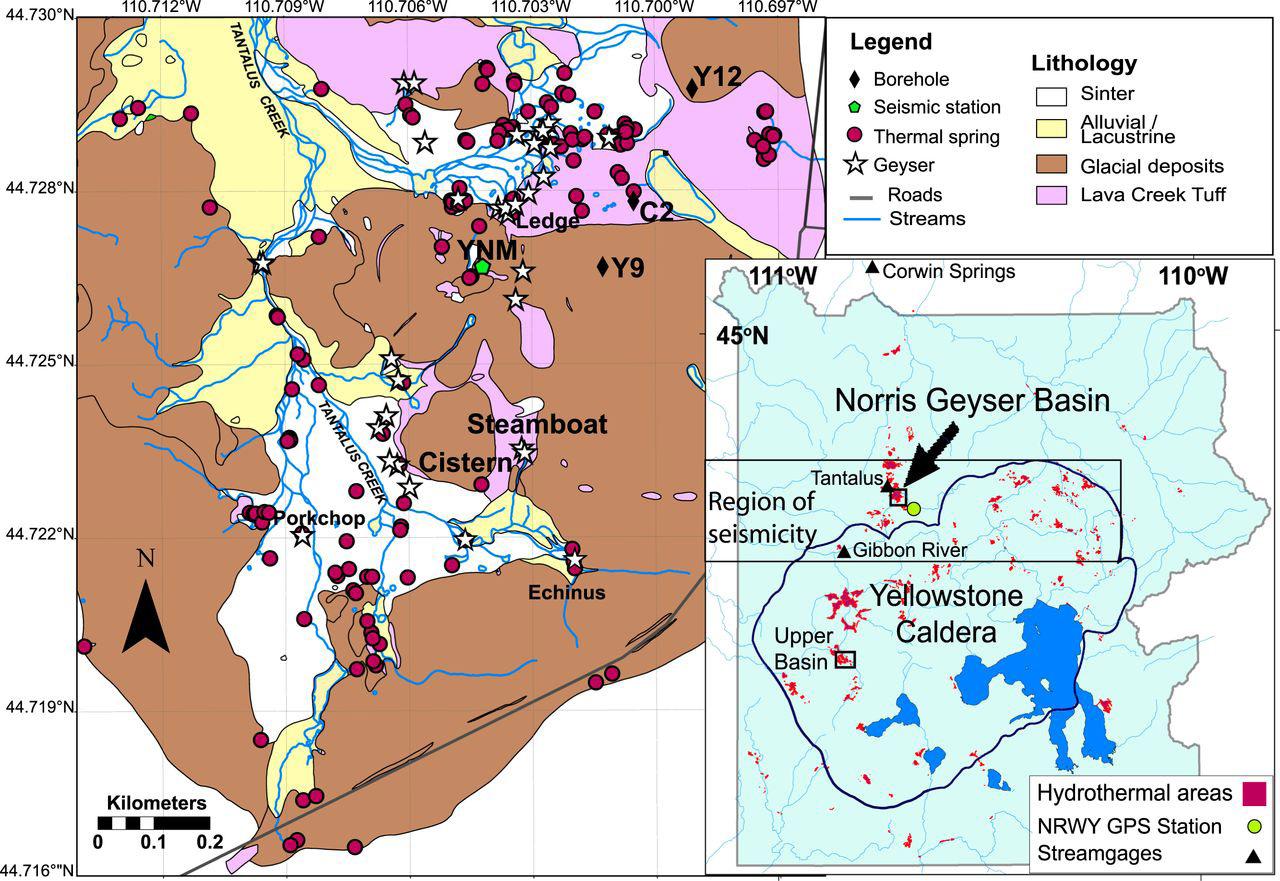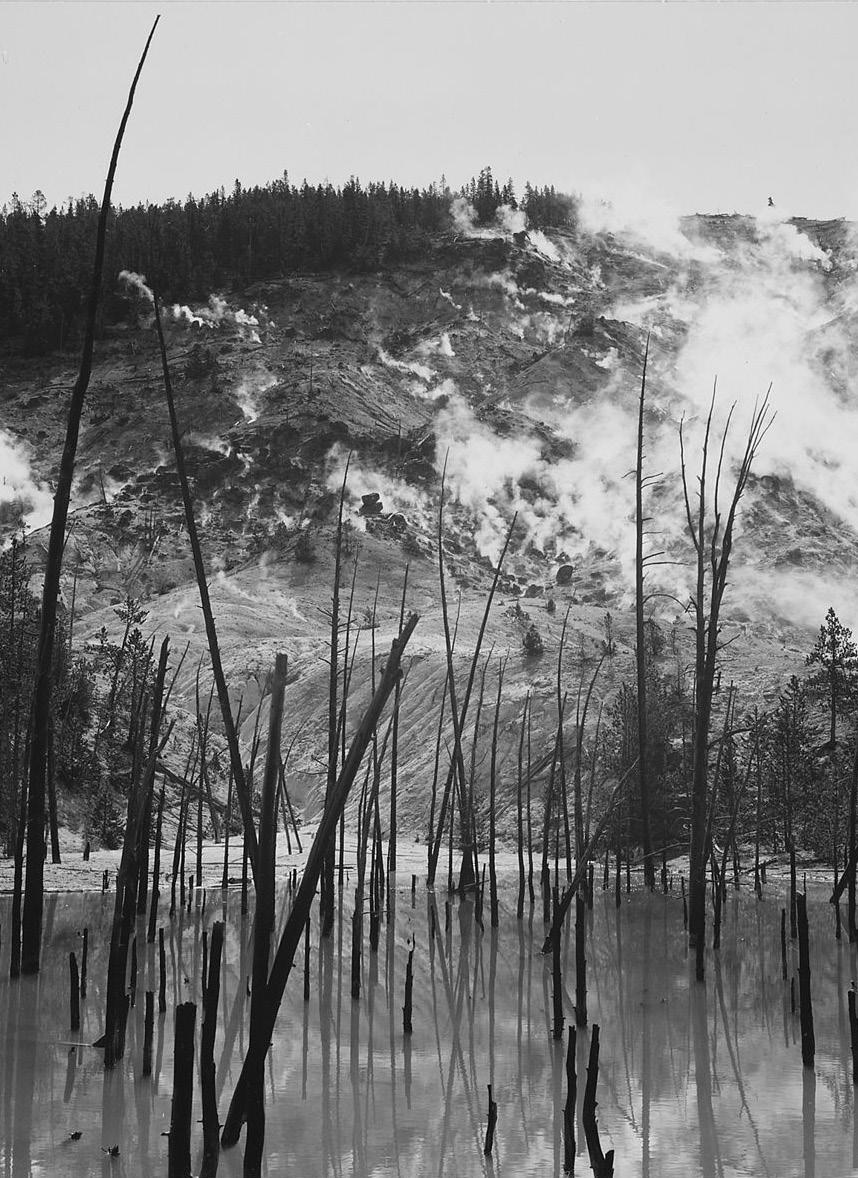
4 minute read
Norris Geyser Basin
from 50 Iterations
by saraholick

NORRIS GEYSER BASIN
Advertisement
Norris Geyser Basin is the hottest, oldest, and most dynamic of Yellowstone’s thermal areas. The highest temperature yet recorded in any geothermal area in Yellowstone was measured in a scientific drill hole at Norris: 459°F (237°C) just 1,087 feet (326 meters) below the surface! There are very few thermal features at Norris under the boiling point (199°F at this elevation).
Norris shows evidence of having had thermal features for at least 115,000 years. The features in the basin change daily, with frequent disturbances from seismic activity and water fluctuations. The vast majority of the waters at Norris are acidic, including acid geysers which are very rare. Steamboat Geyser, the tallest geyser in the world at 300–400 feet (91–122 m) and Echinus Geyser (pH 3.5 or so) are the most popular features.
The basin consists of two areas: Porcelain Basin and the Back Basin. Porcelain Basin is barren of trees and provides a sensory experience in sound, color, and smell; a 3/4-mile (1.2-km) bare ground and boardwalk trail accesses this area. Back Basin is more heavily wooded with features scattered throughout the area. A 1.5-mile (2.4-km) trail of boardwalks and bare ground encircles this part of the basin.
The area was named after Philetus W. Norris, the second superintendent of Yellowstone, who provided the first detailed information about the thermal features.

NORRIS-MAMMOTH CORRIDOR
Norris Geyser Basin sits on the intersection of major faults. The Norris–Mammoth Corridor is a fault that runs from Norris north through Mammoth to the Gardiner, Montana, area. The Hebgen Lake fault runs from northwest of West Yellowstone, Montana, to Norris Geyser Basin. This fault experienced an earthquake in 1959 that measured 7.4 on the Richter scale (sources vary on exact magnitude between 7.1 and 7.8).
These two faults intersect with a ring fracture that resulted from the Yellowstone Caldera of 600,000 years ago. These faults are the primary reason that Norris Geyser Basin is so hot and dynamic. The Ragged Hills around parts of Back Basin and are thermally altered glacial moraines. As glaciers receded, the underlying thermal features began to express themselves once again, melting remnants of the ice and causing masses of debris to be dumped. These debris piles were then altered by steam and hot water flowing through them.
Gibbon Falls lies on the caldera boundary as does Virginia Cascades.

ROARING MOUNTAIN
Located just north of Norris on the Norris–Mammoth section of the Grand Loop Road, Roaring Mountain is a large, acidic thermal area that contains many fumaroles. In the late 1800s and early 1900s, the number, size, and power of the fumaroles was much greater than today.
GIBBON RIVER
The Gibbon River flows from Wolf Lake through the Norris area and meets the Firehole River at Madison Junction to form the Madison River. Both cold and hot springs are responsible for the majority of the Gibbon River’s flow. Brook trout, brown trout, grayling, and rainbow trout live in the Gibbon River.

VIRGINIA CASCADES
A three-mile (4.8-km) section of the old road takes visitors past 60-foot (18.3-m) high Virginia Cascades. This cascading waterfall is formed by the very small (at that point) Gibbon River. The drive may be open to cross-country skiing in the winter.
GIBBON FALLS
This 84-foot (26-m) waterfall tumbles over remnants of the Yellowstone Caldera rim. The rock wall on the opposite side of the road from the waterfall is the inner rim of the caldera.

NORRIS MUSEUM
The Norris Geyser Basin Museum is one of the park’s original trailside museums built in 1929–30. The museum is a National Historic Landmark. Its distinctive stone-andlog architecture became a prototype for park buildings throughout the country known as “parkitecture” (Fishing Bridge Museum and Madison Museum date from the same time period and are of the same style).
Exhibits on geothermal geology, hydrothermal features, and life in thermal areas were installed in in the 1960s and in 1995. The building consists of two wings separated by an open-air breezeway. An information desk is staffed by National Park Service interpreters. An facility of matching architectural style houses a bookstore.

THERMAL AREAS
Artists Paintpots, Beryl Spring, and Monument Geyser Basin are all areas where you can experience hydrothermal activity. Beryl Spring is found right at a pullout along the Gibbon River, making it very accessible.
Artists Paintpots is a small but lovely thermal area just south of Norris Junction. A one-mile (1.6-km) lollipop loop trail takes you to colorful hot springs, two large mudpots, and through a section of forest burned in 1988.
Monument Geyser Basin is at the top of a ridge, making it a bit more strenuous to reach. However, the relative solitude and unique hydrothermal features make the trek worthwhile.











